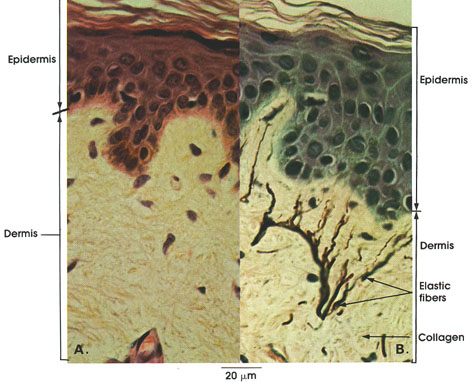

Ronald A. Bergman, Ph.D., Adel K. Afifi, M.D., Paul M. Heidger,
Jr., Ph.D.
Peer Review Status: Externally Peer Reviewed

A. Human, 10% formalin, H. & E., 612 x.
B. Human, 10% formalin, Pinkus' acid orcein-Giemsa method, 612
x.
This figure illustrates the value of special staining techniques in histology. In A, the routine H. & E. method shows clearly the epidermis and dermis. The special technique used in B differentiates elastic fibers from collagen fibers, both of which are important components of the dermis. The H. & E. stain does not specifically reveal elastic fibers. Whereas the elastic tissue stain provides contrasting colors in collagen and elastic fibers, the essential point is that the orcein stain specifically discriminates and delineates elastic fibers from collagen and other tissue components and is therefore an important research tool. In addition, this method provides useful information about tissue and organ structures that the H. & E. fails to provide. The H. & E. stain is a good general method, with marked limitations, which should be appreciated if more than a superficial understanding of microscopic structure and function is to be obtained.
Next Page | Previous Page | Section Top | Title Page
Please send us comments by filling out our Comment Form.
All contents copyright © 1995-2025 the Author(s) and Michael P. D'Alessandro, M.D. All rights reserved.
"Anatomy Atlases", the Anatomy Atlases logo, and "A digital library of anatomy information" are all Trademarks of Michael P. D'Alessandro, M.D.
Anatomy Atlases is funded in whole by Michael P. D'Alessandro, M.D. Advertising is not accepted.
Your personal information remains confidential and is not sold, leased, or given to any third party be they reliable or not.
The information contained in Anatomy Atlases is not a substitute for the medical care and advice of your physician. There may be variations in treatment that your physician may recommend based on individual facts and circumstances.
URL: http://www.anatomyatlases.org/